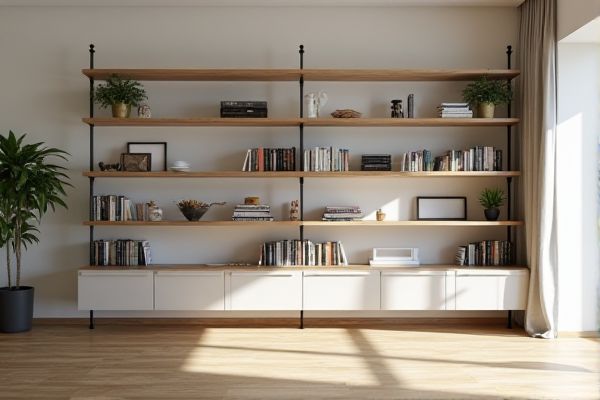
Fixed shelving offers sturdy, permanent storage solutions ideal for heavy or frequently accessed items, while adjustable shelving provides flexibility to customize spacing for varied storage needs. Discover which shelving option best suits Your space and requirements by reading the rest of the article.
Table of Comparison
| Feature | Fixed Shelving | Adjustable Shelving |
|---|---|---|
| Installation | Permanent, fast setup | Flexible, requires additional hardware |
| Customization | Limited to preset height and spacing | Fully customizable shelf height and spacing |
| Strength & Stability | High, designed for heavy loads | Moderate, depends on peg or bracket quality |
| Cost | Generally lower initial cost | Higher due to flexibility and additional parts |
| Use Case | Ideal for uniform storage needs | Best for variable-sized items and changing needs |
| Maintenance | Low, minimal adjustments needed | Requires periodic adjustments and checks |
Introduction to Fixed and Adjustable Shelving
Fixed shelving offers sturdy, permanent storage solutions ideal for heavy or frequently used items, providing stability and maximizing vertical space. Adjustable shelving features customizable heights and configurations, allowing users to adapt storage to various item sizes and changing needs. Both types serve distinct organizational purposes, with fixed shelving emphasizing durability and adjustable shelving prioritizing flexibility.
Key Differences Between Fixed and Adjustable Shelving
Fixed shelving offers sturdy, permanent storage solutions designed for consistent weight-bearing tasks, while adjustable shelving provides flexibility, enabling users to customize shelf heights according to storage needs. Fixed shelves are commonly found in industrial environments due to their durability, whereas adjustable shelves are popular in residential and commercial settings for adaptable organization. The primary difference lies in installation; fixed shelving requires solid anchoring, whereas adjustable shelving utilizes brackets or tracks that allow easy repositioning.
Advantages of Fixed Shelving
Fixed shelving offers superior stability and weight capacity, making it ideal for storing heavy or bulky items with consistent spacing requirements. Its simpler installation and lower cost enhance practicality for long-term storage solutions in warehouses, retail, and residential settings. Fixed shelves maximize usable space without the risk of accidental adjustment or sagging over time, ensuring reliable organization.
Benefits of Adjustable Shelving
Adjustable shelving offers unparalleled flexibility by allowing customization of shelf height and spacing to accommodate varying items, maximizing storage efficiency in homes and commercial spaces. This adaptability supports dynamic organization, making it ideal for evolving storage needs such as books, decorative items, or tools. Enhanced durability with easy reconfiguration reduces the need for additional furniture, promoting cost-effectiveness and long-term utility.
Material Options for Shelving Systems
Fixed shelving systems often utilize hardwood, metal, or engineered wood for durable and sturdy support, making them ideal for long-term, heavy-duty storage. Adjustable shelving typically features steel, powder-coated metal, or high-quality plastic components, allowing flexibility in shelf height and configuration to accommodate varying storage needs. Both material types prioritize strength and resistance to wear, with fixed shelving emphasizing stability and adjustable shelving focusing on versatility.
Installation Process and Complexity
Fixed shelving involves a straightforward installation process, requiring secure mounting points on walls or within cabinets, ideal for those seeking stability and minimal adjustments. Adjustable shelving offers a more complex setup with brackets and tracks allowing customization of shelf height to fit varying storage needs, perfect for dynamic spaces. Your choice depends on whether you prioritize ease of installation or flexibility in organizing your storage areas.
Space Optimization and Flexibility
Fixed shelving offers superior space optimization by providing sturdy, permanent storage ideal for heavy or consistently sized items, maximizing vertical space without gaps. Adjustable shelving enhances flexibility, allowing you to customize shelf heights to accommodate varying items and changing storage needs efficiently. Choosing between fixed and adjustable shelving depends on your priority for either stable, dense storage or adaptable organization tailored to fluctuating requirements.
Durability and Maintenance Considerations
Fixed shelving offers superior durability due to its solid, permanent construction, requiring minimal maintenance and providing long-term stability for heavy items. Adjustable shelving, while offering customization and flexibility, may involve more frequent adjustments and potential wear on brackets and supports, necessitating occasional maintenance to ensure stability. Choosing fixed shelving is ideal for environments prioritizing strength and low upkeep, whereas adjustable shelving suits spaces needing versatility with moderate durability requirements.
Cost Comparison and Budget Factors
Fixed shelving typically offers a lower upfront cost due to simpler design and installation, making it a budget-friendly option for basic storage needs. Adjustable shelving involves higher initial expenses as it requires more materials and flexible hardware, but it provides long-term value by allowing customization to changing storage requirements. Evaluating your storage goals and frequency of reconfiguration helps determine if the cost savings of fixed shelving or the flexibility of adjustable shelving better fits your budget.
Choosing the Right Shelving for Your Needs
Fixed shelving offers sturdy, permanent storage ideal for heavy or consistently stored items, ensuring maximum stability and straightforward installation. Adjustable shelving provides versatility to accommodate varying item sizes and evolving storage needs, allowing easy reconfiguration without significant effort. Selecting between fixed and adjustable shelving depends on the specific storage requirements, space constraints, and frequency of organization changes.
 homyna.com
homyna.com